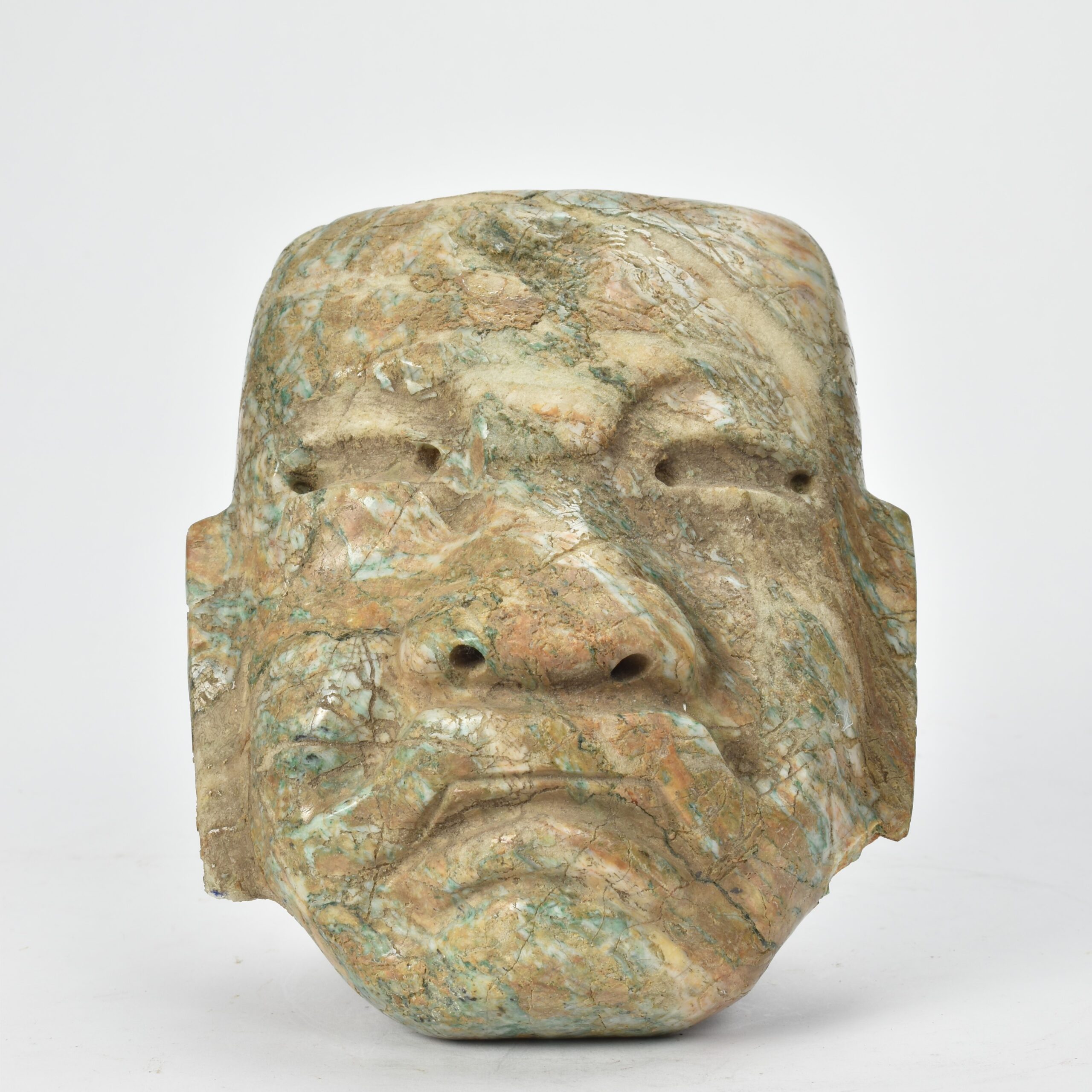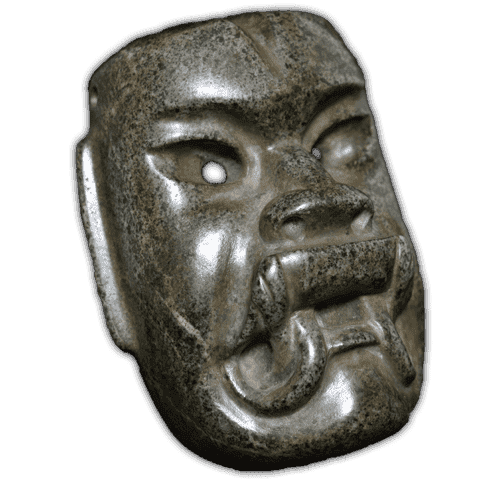Olmec Green Stone Masks: Symbolism and Ritual Significance
The Olmec civilization, flourishing between 1400 BCE and 400 BCE in the tropical lowlands of present-day southern Mexico, is often regarded as the “mother culture” of Mesoamerica. This early civilization left a profound legacy, influencing later societies such as the Maya and Aztecs. Among their most intriguing artifacts are the green stone masks made from primarily, jadeite, and serpentine, many of which depict were-jaguar imagery. Often finely crafted, these masks offer insight into Olmec’s religious, social, and cultural practices.
Symbolism of Green Stone
The choice of green stone was not arbitrary. Jadeite and serpentine held profound symbolic meanings for the Olmec people. The Mesoamerican worldview closely associated green with fertility, growth, renewal, and the life-giving forces of nature. The verdant hues of jade and serpentine evoked the lush vegetation of the Olmec heartland, a region teeming with life and vitality.
Jadeite, in particular, was highly prized across Mesoamerica for its beauty, durability, and symbolic significance. It was often associated with water and maize, both crucial to the sustenance of Olmec society. The green color embodied the essence of life and regeneration, which are essential themes in Olmec cosmology and ritual practices.
Religious and Ritual Significance
The Olmec masks, often found in ritual contexts, were likely used in various religious ceremonies. These masks did not merely serve as decorative items but embodied deep spiritual and ritualistic meanings. Donning a mask, or even the symbolic representation of a mask, could transform the wearer, allowing them to assume the identity of a deity, ancestor, or mythological being.
Olmec’s religion was shamanistic, involving communication with the spiritual world through intermediaries, often depicted as shaman-priests. These shaman-priests likely used masks made from green stone during rituals to invoke or embody supernatural forces. The mask served as a conduit for divine energy, facilitating the connection between the human and the sacred.
Additionally, people might have used the masks in funerary contexts. Some masks have been found in tombs, suggesting that they played a role in burial rituals, possibly serving as protective talismans for the deceased in the afterlife. Using jadeite, a durable and enduring material, symbolized the soul’s eternal nature, aligning with Olmec’s beliefs in life after death.

The Were-Jaguar Imagery
Among the most distinctive and recurring themes in Olmec art is the depiction of the were-jaguar, a hybrid creature that combines human and jaguar characteristics. The were-jaguar motif appears frequently in Olmec masks, sculptures, and carvings, reflecting its importance in their mythology and religion.
Artists typically depicted the were-jaguar with a snarling mouth, almond-shaped eyes, and a cleft head. They believed these features symbolized the transformation of a shaman into a jaguar, representing the merging of human and animal traits. The jaguar, a powerful predator in the Mesoamerican rainforest, was revered as a symbol of strength, agility, and supernatural prowess. People likely saw the transformation into a were-jaguar as a shaman’s ability to harness these qualities and access otherworldly powers.
In Olmec masks, the were-jaguar imagery could indicate the mask’s use in rituals where shamans sought to connect with the jaguar spirit. By wearing these masks, shamans could invoke the were-jaguar’s power, allowing them to undertake spiritual journeys, communicate with deities, or protect their communities from harm.
Artistic and Technical Mastery
The craftsmanship of Olmec green stone masks demonstrates the society’s advanced artistic and technical skills. Despite the hardness of jadeite and serpentine, the Olmecs employed a sophisticated carving technique. Artisans used tools made from harder stones, such as flint or obsidian, and abrasive materials, like sand, to meticulously shape and polish the masks.
The masks often exhibit highly stylized and abstract facial features, characteristic of Olmec art. The faces depicted on the masks usually have almond-shaped eyes, fleshy lips, and a distinct downturned mouth, features believed to represent the Olmec elite or shamanistic figures. The addition of were-jaguar elements further highlights these artifacts’ complex iconography and symbolic depth.
Socio-Political Context
Greenstone masks also had significant socio-political implications. The possession and display of such artifacts signified wealth, power, and status. Jadeite was rare and difficult to acquire, often sourced from distant regions, indicating the extensive trade networks the Olmecs maintained. The ability to procure and work with such valuable material was likely restricted to the elite class, underscoring their authority and divine connection.
The Olmec elite reinforced their socio-political hierarchy by creating and wearing these masks. The masks served as tangible symbols of their elevated status and role as intermediaries between the human and divine realms. This connection to the divine was essential for maintaining their power and legitimizing their rule over the Olmec people.
Legacy and Influence
The Olmec tradition of crafting green stone masks and incorporating were-jaguar imagery did not end with their civilization. Their artistic and cultural practices profoundly influenced subsequent Mesoamerican societies. The Maya and Aztecs, among others, adopted and adapted Olmec motifs and materials in their ritual and creative expressions.
For example, the Maya civilization, which flourished after the Olmecs, also revered jade and used it extensively in their religious artifacts, including masks. The symbolism of green stone as a representation of life, fertility, and divine power persisted throughout Mesoamerican history, a testament to the enduring legacy of the Olmec civilization. The were-jaguar motif also continued to appear in later Mesoamerican art, reflecting its deep-rooted significance in the region’s cultural and religious practices.
Conclusion
The Olmec masks made of green stone and adorned with were-jaguar imagery are more than just remarkable artifacts; they are windows into the complex and rich tapestry of Olmec culture. These masks reveal the civilization’s profound spiritual beliefs, social structures, and artistic achievements. The use of jadeite and serpentine in their creation underscores the significance of these materials in representing life, power, and the divine. The were-jaguar imagery highlights Olmec’s shamanistic practices and connection to the natural and supernatural worlds. As enduring symbols of the Olmec legacy, these masks fascinate and inform our understanding of ancient Mesoamerican civilizations.
Discover the Microscopic Clues: Distinguishing Modern and Ancient Tool Marks on Stone Artifacts
Research Academic Papers and News Articles

